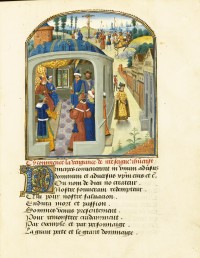 The British Library has acquired an exquisite illuminated manuscript of Mystère de la Vengeance de Nostre Seigneur Ihesu Crist (Mystery of the Vengeance of Our Lord Jesus Christ), a mystery play written by Benedictine monk Eustache Marcadé (d. 1440) some time before 1414 that was enormously popular in the 15th and 16th centuries. It tells a highly fictionalized story of the destruction of Jerusalem by the Romans in the 1st century A.D. as Jesus’ revenge for his crucifixion. It is 14,972 verses long and was performed over the course of four days in elaborate productions that included special effects like flying angels and a leprous Vespasian miraculously healed on stage.
The British Library has acquired an exquisite illuminated manuscript of Mystère de la Vengeance de Nostre Seigneur Ihesu Crist (Mystery of the Vengeance of Our Lord Jesus Christ), a mystery play written by Benedictine monk Eustache Marcadé (d. 1440) some time before 1414 that was enormously popular in the 15th and 16th centuries. It tells a highly fictionalized story of the destruction of Jerusalem by the Romans in the 1st century A.D. as Jesus’ revenge for his crucifixion. It is 14,972 verses long and was performed over the course of four days in elaborate productions that included special effects like flying angels and a leprous Vespasian miraculously healed on stage.
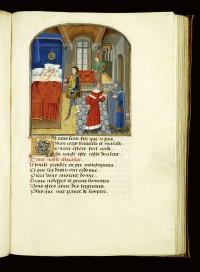 Only two copies of the play are known to have survived and this one is the only complete one. The other copy, now in the Municipal Library of Arras, is 1020 verses shorter, an abridged version that took only three days to stage. The Arras copy is also illustrated with pen and ink drawings, while the British Library’s edition is illustrated with 20 miniatures painted in rich color and vibrant detail by Flanders master Loyse Liédet.
Only two copies of the play are known to have survived and this one is the only complete one. The other copy, now in the Municipal Library of Arras, is 1020 verses shorter, an abridged version that took only three days to stage. The Arras copy is also illustrated with pen and ink drawings, while the British Library’s edition is illustrated with 20 miniatures painted in rich color and vibrant detail by Flanders master Loyse Liédet.
Commissioned by Philip the Good (1396-1467), Duke of Burgundy, Count of Flanders, Artois and Franche-Comté, around 1465, the book is thought to be a record of an actual performance of the Mystère de la Vengeance that was staged in Abbeville in 1483. Abbeville had recently become part of Philip the Good’s territory and it’s very likely that he was in the audience. Wanting a top quality copy of the play, the duke commissioned Liédet to do the art and scribe Yvonnet le Jeune to write out the text in beautiful calligraphy (get a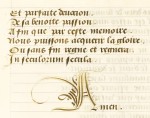 load of the A in Amen). Liédet’s illuminations are thought to be accurate depictions of the play as performed, an important document of medieval theatrical productions from the 15th century.
load of the A in Amen). Liédet’s illuminations are thought to be accurate depictions of the play as performed, an important document of medieval theatrical productions from the 15th century.
Thanks to the ducal library’s extensive record-keeping, we know exactly who was paid how much for which work and how much the materials cost (see this excellent British Library blog entry for details). The total expenditure was an exorbitant 51 pounds and 19 shillings. For comparison, a panel triptych of the Last Supper commissioned in 1464 cost £33 6s. 8d. and Philip’s Master of the Cannon made six pounds a year. This was a luxury edition and then some.
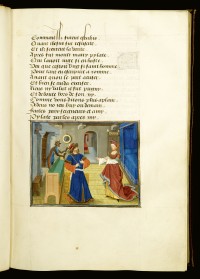 After the death of Philip the Good, it remained in the Burgundian ducal collection until the 17th century when it was acquired by the Marquis de La Vieuville. In the 18th century it was split into two volumes and rebound, but despite the alteration the condition was and is pristine. The book made its way to England in the late 18th century, becoming part of the collection of John Ker, Duke of Roxburghe, whose library was considered the greatest of his age. In the famous 1812 sale of the Roxburghe estate, it was third most expensive lot, purchased by William George Spencer Cavendish (1790-1858), the sixth Duke of Devonshire.
After the death of Philip the Good, it remained in the Burgundian ducal collection until the 17th century when it was acquired by the Marquis de La Vieuville. In the 18th century it was split into two volumes and rebound, but despite the alteration the condition was and is pristine. The book made its way to England in the late 18th century, becoming part of the collection of John Ker, Duke of Roxburghe, whose library was considered the greatest of his age. In the famous 1812 sale of the Roxburghe estate, it was third most expensive lot, purchased by William George Spencer Cavendish (1790-1858), the sixth Duke of Devonshire.
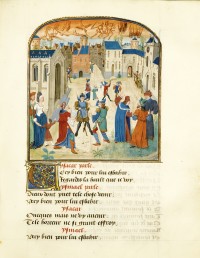 It remained in the library at Chatsworth, seat of the Dukes of Devonshire, for two hundred years. On December 5th, 2012, the Mystère de la Vengeance was put up for auction at Sotheby’s, but the high bid of £3.9 million just failed to meet the reserve of £4 million ($6,442,400) so it didn’t sell.
It remained in the library at Chatsworth, seat of the Dukes of Devonshire, for two hundred years. On December 5th, 2012, the Mystère de la Vengeance was put up for auction at Sotheby’s, but the high bid of £3.9 million just failed to meet the reserve of £4 million ($6,442,400) so it didn’t sell.
Thankfully, they decided not to sell it at auction again. Instead it was acquired by the government under the Acceptance in Lieu (AIL) Scheme, a program that allows important works of cultural patrimony to be transferred to the state in lieu of inheritance tax. 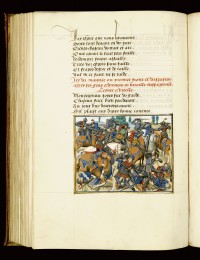 When the market value of the object surpasses the amount of the tax, the owner is paid the difference which is what happened here. The British Library raised the undisclosed amount with grants and donations.
When the market value of the object surpasses the amount of the tax, the owner is paid the difference which is what happened here. The British Library raised the undisclosed amount with grants and donations.
Both volumes of the play have already been digitized and uploaded to the British Library’s outstanding digital manuscripts site: volume one, volume two. To leaf through the book, click on the bindings image and arrow through. It’s very much worth it to zoom in on the illuminations. They are gorgeous and in a very unique style.